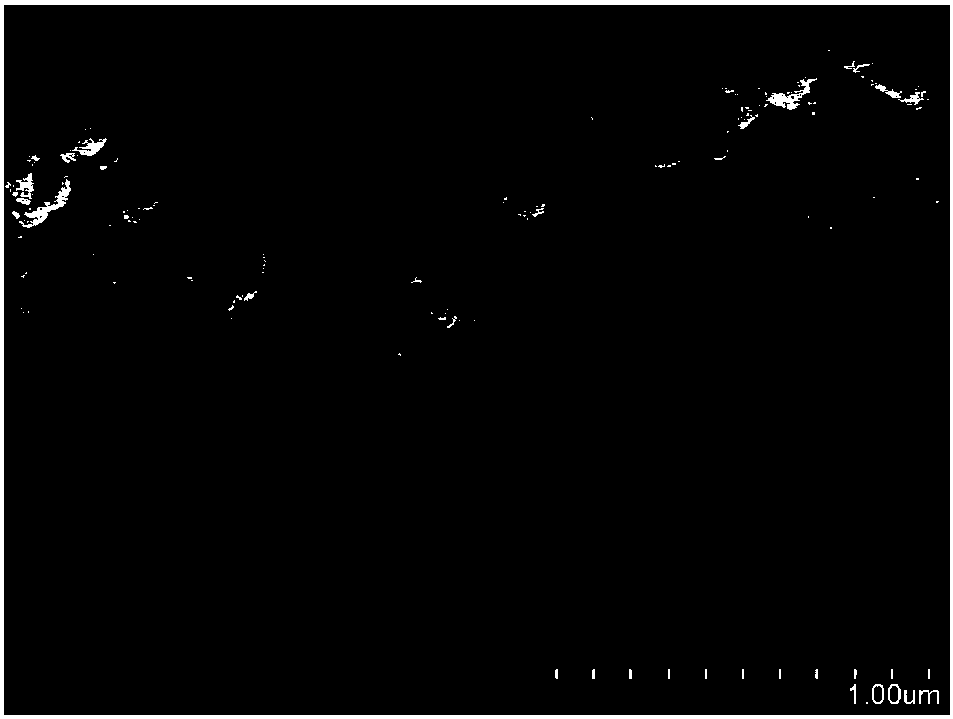Carbon coated lithium ion battery electrode material and preparation method thereof
A technology of lithium-ion batteries and electrode materials, applied in battery electrodes, secondary batteries, nanotechnology for materials and surface science, etc., can solve the problem of large volume change of high-capacity negative electrode materials, limited use progress, and the dissolution of transition metal ions To achieve the effect of improving the structural stability of the surface interface, reducing design and R&D costs, and facilitating industrialized mass production
- Summary
- Abstract
- Description
- Claims
- Application Information
AI Technical Summary
Problems solved by technology
Method used
Image
Examples
Embodiment 1
[0033] Embodiment 1, prepare carbon-coated lithium ion battery electrode material
[0034] (1) First prepare 50 ml of a tetrahydrofuran solution containing 2 g of an alkyne-rich precursor (hexaynylbenzene, compound 1).
[0035] (2) Add 100g LiCoO in step (1) 2 , and fully and uniformly stirred for 2 hours to obtain a slurry.
[0036] (3) The slurry obtained in step (2) was vacuum-dried and treated at 150°C for 3 hours to obtain carbon-coated LiCoO 2 sample.
[0037] The carbon-coated LiCoO prepared in this example 2 The scanning electron microscope image of the particles is shown in figure 1 shown by figure 1 It can be seen that in LiCoO 2 The surface of the particles is evenly coated with a layer of carbon material. The coating of carbon material effectively enhances the conductivity of the electrode, improves the interface contact between the electrode and the electrolyte, reduces the occurrence of side reactions, and stabilizes LiCoO. 2 The material has structural st...
Embodiment 2
[0038] Embodiment 2, preparation carbon-coated lithium ion battery electrode material
[0039] (1) First prepare 40ml of tetrahydrofuran solution containing 2g of alkyne-rich precursor (pentynylpyridine, compound 4).
[0040] (2) Add 120gLiNi in step (1) 0.85 co 0.1 Al 0.05 o 2 , and fully and uniformly stirred for 2 hours to obtain a slurry.
[0041] (3) Vacuum-dry the slurry obtained in step (2), and treat it at 150°C for 3 hours to obtain carbon-coated LiNi 0.85 co 0.1 Al 0.05 o 2 sample.
[0042] The carbon-coated LiNi prepared in this example 0.85 co 0.1 Al 0.05 o 2 The scanning electron microscope image of figure 2 shown by figure 2 It can be seen that in LiNi 0.85 co 0.1 Al 0.05 o2 The surface of the aggregate particles is uniformly coated with a layer of carbon material, which improves the interface contact between the high-nickel positive electrode and the electrolyte, reduces the occurrence of flatulence side reactions, and stabilizes LiNi 0.85 co...
Embodiment 3
[0044] Embodiment 3, preparation carbon-coated lithium ion battery electrode material
[0045] (1) First prepare 100 ml of a tetrahydrofuran solution containing 6 g of an alkyne-rich precursor (tetrakynylethylene, compound 6).
[0046] (2) Add 200 g of Si particles in step (1), and stir fully and uniformly for 2 hours to obtain a slurry.
[0047] (3) Apply the slurry obtained in step (2) to a copper sheet, dry it, and treat it at 400° C. for 1 hour to obtain a carbon-coated Si sample.
[0048] The scanning electron micrograph of the carbon-coated Si nanoparticles prepared in this embodiment is as follows image 3 shown by image 3 It can be seen that the silicon nanoparticles are very uniformly wrapped in the carbon material, and the effective wrapping of the carbon material reduces the pulverization speed of the silicon particles during the cycle and improves the cycle performance of the material.
PUM
 Login to View More
Login to View More Abstract
Description
Claims
Application Information
 Login to View More
Login to View More - R&D
- Intellectual Property
- Life Sciences
- Materials
- Tech Scout
- Unparalleled Data Quality
- Higher Quality Content
- 60% Fewer Hallucinations
Browse by: Latest US Patents, China's latest patents, Technical Efficacy Thesaurus, Application Domain, Technology Topic, Popular Technical Reports.
© 2025 PatSnap. All rights reserved.Legal|Privacy policy|Modern Slavery Act Transparency Statement|Sitemap|About US| Contact US: help@patsnap.com



